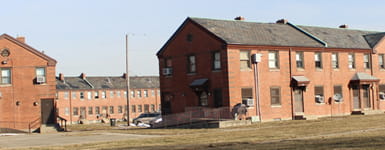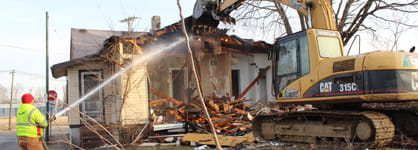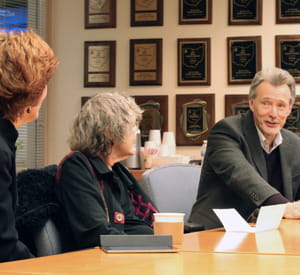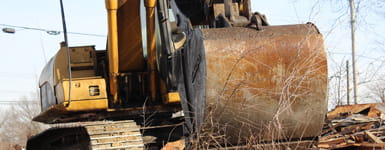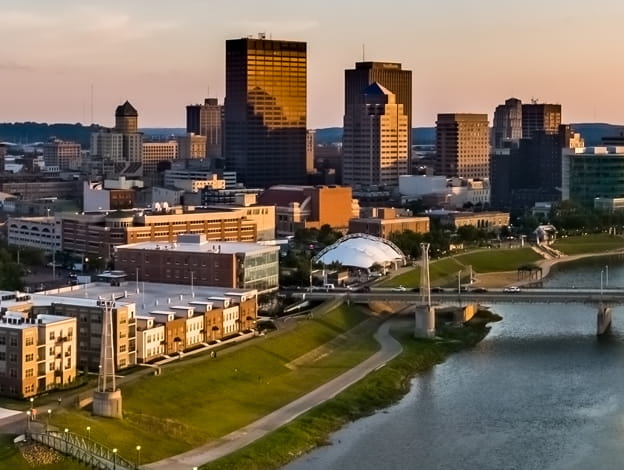UNEMPLOYMENT, VACANT PROPERTIES, POPULATION DECLINE: FINDING SOLUTIONS IN DAYTON
A new jobs-readiness program, a scalable blight-elimination effort, and a comprehensive—and certified—welcome for immigrants are three ways community leaders in southern Ohio are responding to persistent challenges in their region.

The cash register’s roots are here. The automatic car starter’s. Aviation’s, too. Inventors once built factories that put people to work, but today, many of the well-paying blue-collar jobs that attracted people to work and live in Dayton, Ohio, are gone.
Companies that locals figured would be here forever, among them National Cash Register, have left, and parts of the city suffer from disinvestment. In particular, West Dayton, which locals say experienced pronounced segregation and redlining, has higher rates of crime and poverty, along with a very large food desert.
All of the departures and loss, though, have reinvigorated action in some parts. Just last year, for the first time in nearly 15 years, residents’ councils formed at two public housing complexes and are meeting monthly to plan events and voice resident concerns. Block parties have brought together residents and police.
There are bright spots commercially speaking, too: Since 2015, more than 100 new businesses have located downtown, according to the Downtown Dayton Partnership, and signed and renewed leases in 2017 helped chip away at downtown’s vacancy rate. The residential occupancy rate in Dayton’s core is more than 97 percent, even with roughly 760 housing units completed since 2010.
So while the challenges are mighty, locals say they aren’t insurmountable. The headwinds also aren’t unique to Dayton: Many other places have endured industrial losses, and with them, population loss and the painfully evident slide of neighborhoods, amenities, and schools.
“Our city needs a sense of urgency around West Dayton’s disinvestment,” Lela Klein, executive director of the Greater Dayton Union Co-op Initiative, tells Cleveland Fed visitors during a trip in February. “Our city as a whole rises and falls together. You can’t have a strong and resilient city when a significant portion of your population lacks access to opportunity.”
It is Dayton’s response to these challenges that Federal Reserve Bank of Cleveland president Loretta J. Mester and others came to see—particularly, what’s working and what people are attempting to do to turn things around.
Though arguably best recognized for its national monetary policymaking and its supervision of banks, the Federal Reserve is invested in outreach, research, and convening people to understand the economic conditions of the regions it serves. With a focus on low- and moderate-income communities, the Cleveland Fed’s Community Development Department studies issues affecting the Fourth Federal Reserve District, works to identify impediments to solving problems, and shares best practices.
“It’s important for us to know what’s happening in the communities we serve,” says Mester, a voting member this year of the Federal Open Market Committee, the body that sets monetary policy in the United States. “One thing that strikes you as you go around the District is the way things have played out is different across different communities, but there are some common themes.”
Mester and Emily Garr Pacetti, the Bank’s new vice president and community affairs officer, spent a day and a half in Dayton, followed by a briefing from community development stakeholders in Cincinnati. In both Ohio cities, they heard from people who raised shared challenges: employers unable to fill jobs, vacant and abandoned housing, and population loss.
What follow are three ways in which people are working to address them.


Directly across the street from this vacant home in West Dayton is newer affordable housing called Germantown Village. Susie Crabill, program manager with the Montgomery County Land Bank, narrates a driving tour of Dayton neighborhoods.
Disinvestment and reinvestment in Dayton take center stage during a discussion between Dayton leaders, among them Erica Fields of the Human Relations Council, and Cleveland Fed visitors including president Loretta J. Mester (left), who visited to see what’s happening in communities served by the Bank. Prior to a recent cleanup, Lakeside Park, in West Dayton’s Pineview neighborhood, was so overgrown it was hard to find.


JOBS
Removing barriers to employment.
Visitors and colleagues crowd around Terrance Woodruff in a narrow hallway as he describes the people whose pictures are pinned to a bulletin board inside the public housing facility in West Dayton.
“This young man is in a factory,” says Woodruff, coordinator of a program called Jobs Plus Dayton. “This young lady had no people skills and landed a job. This young man here, he was going through the cook’s program. They cook meals for different daycares.”
Each of the people Woodruff points to lives in public housing in Dayton, Ohio, where the public housing authority—Greater Dayton Premier Management—secured approximately $2.4 million to fund a Jobs Plus program for four years, beginning last year. The program addresses poverty among public housing residents by enabling employment through a set of services; Dayton received the Jobs Plus Initiative funds from the US Department of Housing and Urban Development.
Terrance Woodruff, coordinator of a program called Jobs Plus Dayton, speaks inside the facility.
Dayton leaders and Cleveland Fed visitors discuss successes of the Jobs Plus Dayton program inside its facility.
The Jobs Plus Dayton program operates here at DeSoto Bass Courts, a public housing complex.
A computer lab is open to members of Jobs Plus Dayton, a jobs-readiness program that addresses poverty among public housing residents by providing services that enable them to be employed.
Jobs Plus opened in April 2017 at DeSoto Bass Courts, a 350-unit public housing complex, to provide life coaching, soft-skills training, career counseling, and related services to residents of both DeSoto Bass Courts and Hilltop Homes, a 150-unit complex nearby (view map).
DeSoto Bass and Hilltop were chosen because their residents make the least money of public housing residents in Dayton; the average income among their residents is less than $7,000 a year. Jobs Plus is also part of a plan to transform several distressed neighborhoods around the DeSoto Bass Courts public housing complex using a $1.5 million federal grant.
So far, 86 residents are participating in Jobs Plus, and 42 are employed part-time or full-time, most in manufacturing. Half of those employed as of early February were employed at a living wage.
“THEY’RE DESPERATE. EMPLOYERS ARE HAVING RETENTION ISSUES WITH THEIR LOWER-LEVEL EMPLOYEES, AND THEIR HIGHER-LEVEL EMPLOYEES ARE RETIRING.”
— JANICE URBANIK, Partners for a Competitive Workforce
“To have 86 who have voluntarily come out just to participate, and to have almost 50 percent of them employed, is huge in less than a year,” says Kiya Patrick, senior manager with Greater Dayton Premier Management, which administers programs to help low-income individuals and families access safe and affordable housing.
More than 70 participants have enrolled in or completed some education, too, including soft-skills training, obtaining a GED, and pursuing vocational training or college. One woman, organizers share, decided to go back to school to set an example for her grandchildren.
Often what first gets residents interested in Jobs Plus is the promise of a rent freeze, say Patrick and Woodruff.
“One of the biggest fears of long-term public housing residents [in] becoming employed is they’re afraid of losing their benefits, particularly their rent going up,” Patrick says. “With this program, for its four-year term, their [participants’] earned income is disregarded.”
Jobs Plus’s partners help the program meet residents’ needs. Among these partners are CareSource, a large managed care plan provider that runs case management and a workforce development program on site; the Dayton Human Relations Council, which is developing an entrepreneurship program set to roll out later this year; and Legal Aid, which helps participants address legal challenges such as driver license suspensions.
The goal is not to rush residents into programming or jobs, though, Woodruff stresses.
“Some of our individuals may not be ready because they’ve never worked before,” he begins. “If we don’t get to know them, we may set them up for failure.”
To Woodruff, evidence of Jobs Plus’s success is the interest residents are inspiring in other residents.
“Starting off, we had to go out and knock on doors to showcase the program and explain who we are,” he says. “Now that we have 80-some members, they’re going out and saying, ‘You need to join the Jobs Plus program.’”
Asked what the major barriers to employment are, Dayton’s Jobs Plus coordinators list five: lack of a driver license, a criminal background, inability to pass a drug test, lack of transportation, and a need for childcare.
“I TALK TO THE EMPLOYERS, AND WHAT I SAY IS WHEN YOU ARE TRYING TO FIGURE OUT HOW TO GET A NEW CUSTOMER, YOU TRY TO MEET THE CUSTOMER’S NEEDS BETTER THAN YOUR COMPETITION. USE THAT SAME METHODOLOGY, BUT IN THE TALENT MARKETPLACE.”
— JANICE URBANIK, Partners for a Competitive Workforce
Public transportation in Dayton operates across city and county schedules, requiring riders to catch both city and county buses, leading to two-hour one-way commutes to some jobs and limiting where people can travel to work, particularly if they work the night shift or have the additional constraint of obeying childcare business hours. Clearing such transit barriers sometimes entails a short-term fix (lending a resident a bus pass until his or her first paycheck, for example), Woodruff says. Other ideas include providing shuttles to some of the region’s larger employers.
Janice Urbanik, former executive director of Partners for a Competitive Workforce, sees the challenge from another angle: Change relating to employment barriers must come from employers, too—not just potential employees, she insists.
“The discussion needed to change from the skills gap to employer practices,” Urbanik asserts.
What’s an example of a policy that gets in the way of employers’ recruiting, retaining, and advancing talent? Cleveland Fed president Mester asks her in a separate meeting of Cincinnati stakeholders the day after the Dayton visit.
Urbanik offers a few. Zero-tolerance work schedule policies for lower-wage workers who rely on buses to get to work, for instance, make less sense than flexible work schedules. Tuition reimbursement for workers who don’t have the money to pay upfront in order to advance their skills makes less sense than prepaid training.
Road along Lakeside Park in West Dayton’s Pineview neighborhood.
Trolley bus lines overhead in Dayton. Lack of transportation is a major barrier to employment, community leaders say.
Squeals and laughter fill the room of a Dayton church as children play musical chairs.
A public transit trolley in Dayton.
“And you’ve been successful in convincing employers?” Mester asks.
“We’re in the process,” Urbanik replies. “I’ve been on a road trip, talking with employers. A lot of times they don’t think of people in poverty as their own workforces.”
Today’s employment landscape certainly requires employers to give employees more of a value proposition, she later expounds.
“They’re desperate,” she says of employers with jobs to fill. “Everyone’s been talking about the silver tsunami [baby boomers leaving the workforce]. The recession delayed that. Now that the economy is booming, people like me are retiring. Now, it’s real: Employers are having retention issues with their lower-level employees, and their higher-level employees are retiring.”
Couple that with another challenge that Urbanik says is prevalent everywhere: The unemployment rate is so low that the people left seeking jobs tend to be those who face barriers.
“What this all boils down to is employers still think of this as a buyer’s market where they can state, ‘You need to have these skills,’ when it’s really a seller’s market where people have choices,” Urbanik says. “They can choose to work for you or the company next door. I talk to the employers, and what I say is when you are trying to figure out how to get a new customer, you try to meet the customer’s needs better than your competition. Then you continue to deliver on your promises. Use that same methodology, but in the talent marketplace. Who are you going after? What are their needs?”
In response to conversations about employer practices, Urbanik says, some employers have increased wages (one Cincinnati-area manufacturer gave its hourly workers $2 per hour raises). Others have found different ways to add value, for example, testing a shuttle to help people commute. Urbanik is trying to convince employers to lock in spots at nearby childcare centers so new workers who need childcare have a convenient place for their dependents.
Urbanik sees this focus on employer policies and practices spreading across the country. More broadly, the issue of transportation access to jobs is one that has come up across the region the Cleveland Fed serves, says Pacetti, and it’s one the Bank’s Community Development Department is studying. Some research her team is doing now, which will publish later this year, finds that, on average, 20 percent of people taking public transit in the city of Pittsburgh contend with commutes of at least 60 minutes each way, she notes.
“That’s not good for anybody,” says Pacetti, the Cleveland Fed’s community affairs officer. “It’s not good for employers. It’s not good for workers. Jobs access is going to continue to be an area where we spend time, trying to understand best practices.
“We’re specifically interested in the ways the economy is changing and how changes in the economy are affecting people and businesses,” she says. “I want to be sure that we’re not thinking about things the way we thought about things 10 years ago.”
Related Cleveland Fed research:
“A Long Ride to Work: Job Access and Public Transportation in Northeast Ohio”

After Chat
Emerging opportunities and challenges
Even when our tour was over, questions remained for those we met in southern Ohio. We followed up with several of them to learn more.
Q: What emerging economic opportunities or challenges are you seeing impact people that perhaps you didn’t see a year or so ago?

Karen DeMasi,
vice president of community development
CityWide
We’re attracting more jobs to downtown Dayton, which creates more demand for housing and more demand for services. You do need a strong core in downtown.
Also, the new president of the University of Dayton is very outward-thinking in terms of how the university can be more connected to the community in more tangible ways. There are so many ways a university can help.
The other thing is we’re getting a lot of great energy from young people who want to be civically involved, evidenced by groups such as Dayton Inspires and UpDayton. The younger folks are defining it on their own terms, and that’s great. You’ll have social media advertising, and 50 people show up to do something. It’s really exciting for me, seeing young people get interested in economic and community development.
Mike Grauwelman,
executive director
Montgomery County Land Bank
The influence of millennials is very impactful. There’s a shift to an interest in urban living that we haven’t seen in the longest time. Folks who are empty nesters, too, have an interest in moving into urban areas. That market shift is huge in my mind. It’s generating momentum in the urban core, which I think will ultimately [expand] to the next ring of the urban suburban communities.
Kiya Patrick,
senior manager
Greater Dayton Premier Management
I hear there’s a growing population of women who’ve been convicted of felonies, which is adding complexities to housing options and job opportunities. Many subsidized housing programs have rules regarding those convicted of felonies, so they—female felons, many of whom we hear are single moms with children—may not qualify for housing once they get out. Many of the felon-friendly jobs are male dominated. On a positive note, the trades are in need of employees, so there are opportunities there to fill jobs if we can get the right skills training to our residents.

HOUSING
Using land banks to reduce blight.
It’s 3:30 Monday afternoon when we arrive at the pilot of the thriving neighborhoods initiative of the Montgomery County Land Bank. Welcome to Pineview, a community in West Dayton, Ohio, that locals say is on the “tipping point,” in jeopardy of destabilizing.
Along Gettysburg Avenue, a thoroughfare bordering Pineview, some buildings are crumbling. More than one property has gaping holes in its roof. Stark black boards make others’ openings impenetrable. Off the main road, on streets lined with slab homes, the occasional vacant property lurks next to homes with trash cans on the tree lawn.
“It [the blight on Gettysburg Avenue] doesn’t inspire confidence that there’s a nice neighborhood sitting behind it,” says Mike Grauwelman, executive director of the Montgomery County Land Bank.
The land bank’s goal is to remove buildings with a blighting influence in order to restore property values and encourage neighbors to invest in their homes.
A resident once told Grauwelman, “I used to have a lot of pride in my own home. It needed TLC. But I have this sitting next to me.” “This” was a home with a hole in its roof.
“Why would you [invest]?” Grauwelman poses to Cleveland Fed officials. “You don’t have any confidence in your own property value going up anymore. That [deteriorated motivation to invest] is just pervasive.”
Pineview’s property values enjoyed a high of $44 per square foot in 2006 before dropping to a low of $11 in 2013. They now hover near $23 per square foot.
To help keep neighborhoods such as Pineview from slipping further downhill, the land bank is acquiring distressed properties so that it can remove blight through its thriving neighborhoods initiative. Presently, it is planning to foreclose and acquire 14 properties in Pineview. It will renovate four; the rest, it will tear down. Renovation versus demolition is an economic decision: Do improvements to a structure cost more than the values of neighboring homes?
Dayton’s Pineview neighborhood, where this vacant home stands, is one of five distressed neighborhoods civic and community leaders plan to transform using a $1.5 million federal grant.
The lake at Pineview’s Lakeside Park now sports a new fishing pier after major cleanups by groups including the Ohio AFL-CIO, the Union Sportsmen’s Alliance, and the University of Dayton River Stewards.
Heavy brush (right) made it hard to find Pineview’s Lakeside Park (left) before recent cleanups. Courtesy of Karen DeMasi
One window of a vacant house in West Dayton’s Pineview neighborhood.
Grauwelman describes these efforts as “setting the table” for private investment by generating confidence in the neighborhood and the market. Grauwelman’s goal is to mitigate problem properties in 30 challenged low- and moderate-income neighborhoods over five years. But the land bank can’t do it alone.
The land bank has committed to two neighborhoods a year and seeks external partners to fund its ability to ramp up to five or six a year. The goal is to raise $5 million to $6 million from lenders and other organizations. (Land bank officials anticipate that bankers may be motivated to participate by their obligation to comply with the Community Reinvestment Act.)
If the land bank finds the partners it needs to expand this initiative to 30 neighborhoods, those involved project they’ll directly and indirectly impact 25,500 residents and 11,100 housing units, demolish 300 structures, renovate 360 structures (most through private investors), and bring about a 20 percent increase in property values.
To identify which places are on the “tipping point,” the organization considers vacancies, foreclosures, changes in property values over time, and the proportion of a neighborhood’s properties that are owner-occupied versus renter-occupied, Grauwelman explains. Most of these neighborhoods they’ll find in Dayton itself or in the surrounding areas, he says.
Land bank officials want to integrate their real estate work with other efforts, so they also consider whether a would-be target neighborhood has a local group willing to join forces with the land bank or already at work there. For example, the land bank chose Pineview knowing the city of Dayton and Greater Dayton Premier Management had secured a $1.5 million federal grant to transform five distressed neighborhoods around the DeSoto Bass Courts public housing complex, Pineview being one of them.
Countywide, “it’s going to take a long time to demolish what’s out there,” Grauwelman says, citing the 2010 census finding of 12,159 “other” properties, which land bank officials say are vacant and abandoned properties. It’s going to take a lot of money, too: Between 2013 and 2019, the land bank will have demolished 1,700 properties at a cost of 25.5 million federal, state, and local dollars.
Why so much vacant property? For one, Montgomery County Treasurer and land bank board chair Carolyn Rice says, Ohio used to be one of two states without laws against predatory mortgage lending, a situation that contributed to historic volumes of foreclosures before the Great Recession; for another, Dayton has lost thousands of the automotive and manufacturing jobs that employed people who lived in Pineview and similar places.
“We’ve got to stabilize properties,” Rice says. “Get them turned around and starting to produce [tax] revenue.”
Land banks operate in probably half of Ohio’s counties and often are funded by a portion of the delinquent tax and assessment monies collected by treasurers, according to Rice. Montgomery County’s land bank operated with a skeleton volunteer crew for its first two years prior to recruiting Grauwelman in late 2013. While a majority of its efforts are focused on the city of Dayton and inner-ring neighborhoods, the land bank helps other county municipalities address problem properties, too.
And given ongoing economic changes, the vacancy of residential properties isn’t the only pressing need, Grauwelman notes.
“Our society is changing in many different ways,” he says, “and one way is the impact of the internet on how we conduct business and where we live our lives.”
Work that used to fill large office buildings isn’t tethered to office space anymore, as more workers earn their livings from home and coffeehouses, he notes. Malls have become outdated, he explains, and Amazon’s delivering items fast to shoppers’ homes is prompting change for the big-box stores that dot many community landscapes. It all requires adjusting to evolving market realities.
“The new model for retailers [is that] a lot of their business is being conducted over the internet with just-in-time delivery,” Grauwelman says. “[Some stores’] retail footprint is going to be about half the size or less [than it used to be].
“It’s just an evolution,” he adds. “Oftentimes, it leaves remnants on the landscape of particular market segments.”
Curious what this property at 1646 Germantown Street looked like before demolition? See the before via Google Maps.
Many communities across the country have neighborhoods in distress, says Mike Grauwelman (right) of the Montgomery County Land Bank. Cleveland Fed president Loretta J. Mester (left) visited to better understand what’s happening in low- and moderate-income communities.
An excavator tears down a vacant house acquired by the Montgomery County Land Bank at Germantown Street and Danner Avenue near DeSoto Bass Courts.
Demolition of a land bank-owned property is underway by 8:40 am on February 13, 2018.
“Could you go faster if you had more money? Is it scalable?” Cleveland Fed president Mester asks him of the land bank’s efforts.
Grauwelman nods, and Rice chimes in.
“We’re trying to figure out how we can make the case to our legislature that we need to find funding,” she says. “The local communities don’t have the monies that are needed. We want to keep blight elimination going. Money is huge.”
“THE LOCAL COMMUNITIES DON’T HAVE THE MONIES THAT ARE NEEDED.”
— CAROLYN RICE, Montgomery County
Mester also asks if the land bank has quantified the benefits of clearing neighborhoods of problem properties. Putting a number to the return on investment is a challenge, Grauwelman replies. The organization spends an average of $16,000 to demolish a single residential property, and sometimes the tangible end result is a vacant lot. On the plus side, Rice notes, one has to attribute rebounding property values in some neighborhoods to blight reduction.
“That should help you make the business case”—comparing communities where you were active to those where you weren’t, Mester replies.
“I’m particularly interested in identifying programs and policies that are working and figuring out whether they are scalable and replicable,” Mester explains later. “Maintaining the relationships we have built with the people and the organizations we met in Dayton is important because it helps inform our research.”
Related Cleveland Fed research:
“Home Lending in Montgomery County Neighborhoods”
“Neighborhood Change in the Fourth Federal Reserve District: A Multivariate Approach”
“The Impact of Vacant, Tax-Delinquent, and Foreclosed Property on Sales Prices of Neighboring Homes”

After Chat
Key challenges facing Dayton’s practitioners
Even when our tour was over, questions remained for those we met in southern Ohio. We followed up with several of them to learn more.
Q: What’s the biggest challenge you encounter in your line of work?
Carolyn Rice,
treasurer
Montgomery County
The obstacle I see is the funding. The communities don’t have the kind of money that’s needed. We need to get on the radar with whoever’s running for governor as well as the legislature. We need to make the case and make the request. We need to be the noisy wheel. This [addressing vacant and abandoned properties] is a real need in communities.
Mike Grauwelman,
executive director
Montgomery County Land Bank
The problem [for distressed communities] is not just one of a building or two that needs to be torn down or renovated. There’s a group of social issues that the land bank is not in a position to impact—crime, for example. The provision of a variety of services. Having a local grocery store. It’s a big, complex problem. For us the question is, what is our piece? We hope through our planning process we can articulate what the issues are and identify partners who do [needed] work. Many efforts are somewhat fragmented. Can we bring all these partners together? Can this thriving neighborhoods initiative be a rallying point for others?
Janice Urbanik,
former executive director
Partners for a Competitive Workforce
Employers who have tunnel vision around what the issue is [behind their inability to fill jobs] and the right way to solve it. Also, the workforce [development] field is very crowded, and that’s okay because there’s more than enough work to go around, but a lot of times we get into turf issues that are not productive. A lot of organizations are focused on who gets credit because they have to report to their funders, members, somebody.
Kiya Patrick,
senior manager
Greater Dayton Premier Management
There are so many needs and very few resources. A perfect example is transportation. We wish we had a resource to be able to provide permanent transportation to all of the residents who need it. We wish there were resources for RTA to add more routes, more shuttles, but there aren’t. We wish we could continue this [Jobs Plus jobs-readiness training and life coaching] program. Four years will make a difference in the lives of some of our residents, but we need probably 10 years to see a change in aggregate income levels. But our grant is only for four years.
Karen DeMasi,
vice president of community development
CityWide
The funding base for community development has been eroded. The cities don’t have the tools they used to have. We had revenue-sharing that came to the cities, much larger allocations from the federal government of Community Development Block Grants. These things have been slowly cut back.
IMMIGRATION
Welcoming immigrants and supporting small businesses.
Like many cities where the manufacturing footprint has shrunk, Dayton has suffered population loss. As of the 2010 census, the city’s population was down nearly 15 percent from 2000, dropping from 166,303 people to 141,527.
The city’s immigrant population has grown, though, and Dayton’s efforts to support immigrants made it the first city in the nation to become “Certified Welcoming” by an organization called Welcoming America, Dayton locals tell Federal Reserve officials. The city earned this designation last year.
Between 2009 and 2013, while the native-born population of Dayton dropped by 8.6 percent, the foreign-born population increased by 58.8 percent, according to a report by the Partnership for a New American Economy and a local program named Welcome Dayton.
“IMMIGRANTS HAVE A HUGE IMPACT ON OUR NATION’S ECONOMY. THEY ARE TWO TIMES AS LIKELY [AS US-BORN CITIZENS] TO BE ENTREPRENEURS.”
— MONICA HARRIS, Welcome Dayton
“Is that because Dayton did something to attract immigrants?” Cleveland Fed president Mester asks.
Monica Harris, coordinator of Welcome Dayton, a program formally adopted in 2011, hypothesizes it’s largely a result of the area’s affordability. “I’m from Seattle and New York,” says Harris, who’s new to her role. “It’s a more affordable place to live.”
And once one person resettles to an area, his or her family is likely to follow, another meeting participant notes.
The top five countries of origin for immigrants to the United States who settle in Dayton are India, Mexico, the Philippines, Russia, and Turkey.
Welcome Dayton, an initiative of the Dayton Human Resources Council, has two driving strategies: first, to educate the native-born population on the benefits of being a welcoming community, and second, to reach out to immigrants, including refugees, through events, education, and immigrant-resource specialists. Harris points to “Voices of the Immigrant Experience” events, which are hosted by community members and organizations, as one effort that helps humanize immigration.
“We know if people can meet someone who’s immigrated to the US [and is] doing positive things in the community, it helps to break down barriers and fear,” Harris says.
In certifying places as “welcoming,” Welcoming America considers how well a place meets criteria in seven categories: government leadership, civic engagement, equitable access, education, connected communities, economic development, and safe communities.
Dayton’s efforts to support immigrants made it the first city in the nation to become “Certified Welcoming” by an organization called Welcoming America.
The Great Miami River, shown in this photo, divides East Dayton and West Dayton. The west side suffers disinvestment, including the recently announced closure of its last grocer.
RoShawn Winburn (right) explains to Cleveland Fed visitors how the Minority Business Assistance Center in Dayton helps small businesses secure both funding and technical assistance.
In Dayton’s September 2017 audit by Welcoming America, leaders learned one area they can strengthen is economic development, an example of which is improving immigrants’ financial literacy and understanding of the US financial system. The audit finding is one reason Welcome Dayton is partnering more deliberately with the Minority Business Assistance Center (MBAC) in Dayton. One early plan is to provide more small-business programming in multiple languages.
“Immigrants have a huge impact on our nation’s economy,” Harris says. “They are two times as likely [as US-born citizens] to be entrepreneurs.”
But language barrier is only one challenge immigrant entrepreneurs face, Harris says. Because they lack a credit history here and are unfamiliar with different regulations, immigrant business owners also can struggle to obtain funding such as loans.
“I THOUGHT IT VERY USEFUL TO HEAR ABOUT WHAT PEOPLE ARE THINKING ABOUT AND DOING.”
— LORETTA J. MESTER, Federal Reserve Bank of Cleveland
The MBAC offers services to help in ways ranging from helping to secure capital to providing and finding technical assistance. Many immigrants fall into the center’s target populations of socially or economically disadvantaged business owners, explains RoShawn Winburn, program director of the MBAC.
“The way you do business in one country is not necessarily how you do business in another,” Winburn says. “In some cultures, there’s a distrust of government, so [immigrants may not] see me as help. They see me as an enforcer.”
One of seven main locations throughout Ohio, the MBAC in Dayton certifies firms that qualify as women owned, minority owned, small business, and economically disadvantaged. The primary benefit of certification is preference when a project requires a contractor or contractors to meet diversity and inclusion goals, Winburn says.
“If there’s $1 of public funds in a project, whether through federal or local government, then there’s usually a requirement to have some sort of diversity and inclusion goal,” he explains.
And the center is being tapped increasingly to identify certified companies as local construction work heats up, Winburn says.
Hearing in real time about challenges and opportunities such as these is important, Mester says.
“I thought it very useful to hear about what people are thinking about and doing,” she says. “The data are useful, but you hear about things [through visits such as these] much earlier than they show up in the data.
“There are a lot of very hard things to think through,” Mester tells community leaders, citing the concentrated poverty and vacant housing they’ve described. “Having your expertise to guide us so we can influence policy in the right direction, is very helpful.”
Related Cleveland Fed research:
“2016 Small Business Credit Survey: Report on Minority-owned Firms”
“Do Foreign-Born Workers Cause Native-Born Workers to Move or Leave the Labor Force?”

After Chat
Lessons in community development
Even when our tour was over, questions remained for those we met in southern Ohio. We followed up with several of them to learn more.
Q:What community development lessons have you learned that you’d share with people trying to improve outcomes in other historically industrial places like Dayton?
RoShawn Winburn,
program director
Minority Business Assistance Center
Communication and collaboration are key. When you start talking about economic development or community development, everybody has an idea that they think is new or novel. There are lots of wasted meetings and resources to create [things] that organizations may [already] be working on. If we communicate, we can find that out and leverage each other’s resources to get more done.
Mike Grauwelman,
executive director
Montgomery County Land Bank
One of the things that’s critical for us is that the neighborhoods be organized and have ownership. It’s not about what the land bank does—it’s about what the neighborhood does with [renovated property and/or a cleared lot] after the land bank does what it will do. The long-term sustainability of anything we do is in the hands of the people who live there.
Monica Harris,
coordinator
Welcome Dayton
The most important lesson I have learned is the need for meaningful community engagement from the outset. This means that I, the outsider, don’t go into a community with all of my own ideas for what I think the community needs. Instead, I need to talk and really listen to all the relevant players, including—and especially—those who have been most affected by historically negative events. I need to find out what the community wants and believes it needs, and understand the assets that already exist in a community—community members are the experts on their communities. Listening to and working alongside them is the only way to secure community buy-in, improve long-term success, and increase the likelihood of an initiative’s sustainability.
Kiya Patrick,
senior manager
Greater Dayton Premier Management
We need partners who can understand what’s happening on the ground, but then we also need partners who have the capacity to understand the systemic issues so people can fight the good fight on the ground and people can fight the inefficiencies on the statewide and federal levels so that collectively we can have greater impact. It’s a lesson learned that we are working on. We recognize that there are people who are doing those things, but we need to get them all to the table to talk.
THE VOICES
Here are 11 people who met in early 2018 to discuss opportunities and challenges in southern Ohio.

Loretta J. Mester — President and chief operating officer | Federal Reserve Bank of Cleveland
Loretta J. Mester — President and chief operating officer | Federal Reserve Bank of Cleveland

Lela Klein — Executive director | Greater Dayton Union Co-op Initiative
Lela Klein — Executive director | Greater Dayton Union Co-op Initiative

Monica Harris — Coordinator | Welcome Dayton
Monica Harris — Coordinator | Welcome Dayton

RoShawn Winburn — Program director | Minority Business Assistance Center (Greater Dayton)
RoShawn Winburn — Program director | Minority Business Assistance Center (Greater Dayton)

Kiya Patrick — Senior manager | Greater Dayton Premier Management
Kiya Patrick — Senior manager | Greater Dayton Premier Management

Carolyn Rice — Treasurer | Montgomery County
Carolyn Rice — Treasurer | Montgomery County

Emily Garr Pacetti — Vice president and community affairs officer | Federal Reserve Bank of Cleveland
Emily Garr Pacetti — Vice president and community affairs officer | Federal Reserve Bank of Cleveland

Janice Urbanik — Former executive director | Partners for a Competitive Workforce
Janice Urbanik — Former executive director | Partners for a Competitive Workforce

Mike Gauwelman — Executive director | Montgomery County Land Bank
Mike Gauwelman — Executive director | Montgomery County Land Bank
THE WAYS WE LISTEN
The Cleveland Fed's Community Development Department seeks to understand issues affecting low- and moderate-income communities in the Fourth Federal Reserve District. Because economic data can lag behind current conditions and experiences, we listen in other ways, too.
Trips like the one Cleveland Fed officials took to Dayton, Ohio, in early 2018 are one way the team gathers real-time information about people’s economic experiences.


Ways we listen
- Meet with people from the community, the workforce, and economic development organizations, the private sector, philanthropies, academia, and the banking community
- Convene stakeholders at our biennial Policy Summit, conferences and events, and listening sessions
- Survey employers, direct service providers, and community members

Ways we use what we hear
- Conduct applied research using data to understand real-world challenges (Ex: transit access to jobs and barriers to securing capital in lower-income communities)
- Produce and publish reports and case studies
- Share best practices with decision makers and policymakers

Ways we give back
- Build relationships and partnerships to coordinate resources needed for meeting pressing needs
- Produce and publish research relevant to the region and its issues


